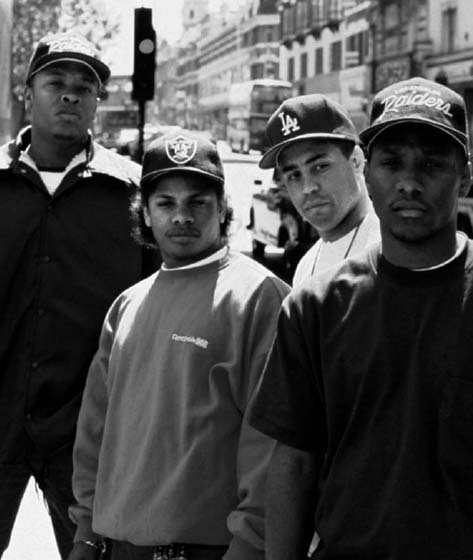The Encyclopedia of Dead Rock Stars (172 page)
Read The Encyclopedia of Dead Rock Stars Online
Authors: Jeremy Simmonds

Close!
Mike Nolan
(Bucks Fizz)
Just what is it about Eurovision types and tour buses? In December the following year, another former winner’s coach was also involved in a calamitous accident. After the collision with an articulated lorry in Newcastle, it was believed Bucks Fizz pin-up boy Mike Nolan might never walk or indeed speak again, the head injuries he’d incurred putting him in a coma. Good fortune prevailed, however, and the singer recovered to return to the studio within six months. For the Fizz, though, all fell flat with a split coming after just one further hit record.
Sunday 26
Eazy-E
(Eric Wright - Los Angeles, California,
7 September 1963)
NWA

There are many who see Compton-born Eric Wright as the true godfather of gangsta rap. As the notorious Eazy-E, he kickstarted the brief but brilliant life of NWA (Niggaz With Attitude), building his independent label, Ruthless, on previously ill-gotten gains. Teaming up with DJs Dr Dre (Andre Young) and Yella (Antoine Carraby), Eazy-E refined an originally sprawling roster to the classic NWA line-up – himself, Dre, Yella plus Ice Cube (O’Shea Jackson) and MC Ren (Lorenzo Patterson). Although Eazy’s own album,
Ea%y Du% It,
was released the same year, it was NWA’s
Straight Outta Compton
(1989) that really shocked a nation with its thinly concealed illustrations of the brutality of LA street life. The album, NWA’s second, contained such rap flashpoints as ‘Gangsta Gangsta’ and, most notably, the incendiary ‘Fuck tha Police’. This pivotal track was written as a direct response to the violent treatment E and Dre had received at the hands of the LAPD as a result of an ill-advised drive-by paintballing the pair had dished out to some innocent bystanders one afternoon. An FBI attempt to block the record’s distribution gained enormous publicity for NWA, ensuring that the album thereafter went platinum – and that its main architects, including E, would pocket six-figure salaries the following year. Another of the group’s biggest hits was ‘Express Yourself’, a stirring call to arms to the black underclass that echoed closely a song written by Eazy-E’s own musician father, Charles Wright, in 1970. Said his manager, Jerry Heller, ‘[E] was the most Machiavellian guy I ever met. He instinctively knew how to control people – and his musical instincts were infallible.’

NWA: No one dared drop the ‘E’
(second left)
An eventful, if short, career for E was to follow: after two further albums, NWA split acrimoniously in 1990, fuelling a highly public power struggle between Eazy and Dr Dre, who teamed up in 1992 with the notorious ‘Suge’ Knight to form Death Row Records. (The new label’s roster included new rap heavyweights Snoop Doggy Dogg and Tupac Shakur.) Beginning a hip-hop trend for dissing the enemy on records, Dre cast the first stone; Eazy’s reaction to what he clearly saw as treachery was to issue an entire full-length LP,
It’s On (Dre) 187um Killa
(1993) – little more than a prolonged fantasy involving the shooting of Dre plus one or two of his new charges, including the rising Snoop. This pretty grievous dissing of his former friend was full of bitter vitriol (see ‘Real Muthaphukkin Gs’), on top of which E included doctored images of Dre wearing lipstick and eyeliner on the sleeve – the ultimate insult in the gangsta fraternity. The legions of fans who had been faithful since NWA days, however, loved this very open spat between their two idols. In the aftermath, E kept followers on their toes, to say the very least, by orchestrating a brief but extraordinary pact with President George Bush, donating money to the Republican Party. He then issued a startling endorsement of the LAPD officers involved in the notorious 1993 Rodney King trial, dining with one of the accused, Tim Coon, and baldly stating, ‘They was jus’ doin’ their job!’ Ruthless meanwhile continued as a going concern, and E showed his ability to spot raw talent by discovering Bone, Thugz & Harmony, whose debut album for the label also went platinum.
A natural showman, and always in love with the notion of being rap’s bad boy, Eazy-E fathered seven children by six partners before learning he was carrying the AIDS virus. E only went public with his condition a few weeks before he succumbed to it, marrying girlfriend Tomika Wood and finally reconciling with first Cube, then Dre at the Los Angeles Medical Center as he awaited death. A typically brash open letter from the dying star read: ‘I would like to turn my own problem into something good that will reach out to my homeboys and their kin, because I want to save their asses before it’s too late.’ On the day of E’s funeral, then Mayor of Compton, Omar Bradley, declared him ‘Compton’s favourite son’ and even announced an ‘Eazy-E Day’ in recognition of the artist’s immortalization of the LA suburb. Given Bradley’s stark denouncement of NWA two years before (for portraying Compton as ‘a gang-ridden cesspool), it was a remarkable climb-down – and very much cemented Eazy-E’s improbable acceptance by Californian authorities.
Friday 31
Selena
(Selena Quintanilla - Lake Jackson, Texas, 16 April 1971)

US popular culture more than occasionally throws up stories that test the credulity of all but the most avid made-for-TV-movie fan, surreal episodes like those involving sporting heroines Tonya Harding or Monica Seles that seem constantly to overshadow news of genuine world significance. One of the more puzzling tales of this nature was the pointless death of young Tejano singer Selena Quintanilla Perez – better known to her legions of young fans simply by her first name. Selena was born to celebrated Tex-Mex vocalist Abraham Quintanilla, who was to mould her career from an early age, putting her on stage at his newly opened restaurant when she was just nine, at the front of a hastily assembled band, Selena y Los Dinos (‘Selena & The Guys’). Selena – revamped as a bustier-clad sex siren – then reemerged at the tail end of the eighties with a string of carefully manufactured crossover pop recordings. Despite the plainly sterile nature of her music, Selena’s major label debut,
Entre a Mi Mundo,
topped the Tex-Mex charts, while she also smashed a non-sport attendance record at the Houston Astrodome in 1992. It was at this stage in her career that Selena’s father figured that his daughter would need a fan club to sate the seemingly unquenchable enthusiasm of her followers. One of the most vociferous of these was an otherwise dour 32-year-old woman called Yolanda Saldivar.

Selena: Someone came into her world
A registered nurse from San Antonio, Saldivar wore Abraham’s resistance down until he agreed to let her manage the club and organize some of the star’s business interests. Well, it made perfect sense: things were hotting up for Selena, who was now married and had a huge Latin crossover hit with ‘Como La Flor’ (1992), topping off a triumphant year with a Grammy. Tejano (a mix of Texan and Mexican stylings) was big business, and the media was soon talking of Selena as a ‘Latina Madonna’ set to usurp the convalescing Gloria Estefan in her absence.
All seemed fine for the first year or two of Saldivar’s ‘organization’ – at least superficially. She had built up the fan club sufficiently to warrant ditching her day job, and was soon allowed to oversee the running of one of Selena’s two boutiques. But Saldivar’s business methods – which clearly should have been monitored more closely by the star and her family – were far from sound. Her obsessive, over-protective supervision of Selena brought complaints from fans across the USA: some believed her to be driving a wedge between the singer and her audience, while, more prosaically, many more claimed to have received nothing for their $20 administration fee. Which is where the story takes its sinister turn.
Perturbed, Selena – who naively thought well of Saldivar – questioned her about the increasing allegations of fraud. This was met with howls of protest from her employee, who bizarrely used a trumped-up claim of rape to conceal her guilt. A legally enforced hospital examination made the tearful Saldivar change her story, but before any kind of proper financial investigation could commence, Saldivar fled to Mexico – taking with her some fairly damning documentation. With the situation fast spiralling out of control, she agreed to meet the singer and her guitarist husband, Chris Perez, at a Days Inn motel in Corpus Christi, Texas. After a frantic argument in the unlikely surroundings of this tiny hostelry, Saldivar locked herself in her room, refusing to relinquish the crucial documents. With her spouse rapidly losing his patience, Selena agreed to leave her distressed employee for the night, to return home and then attempt to speak to her the following morning alone. It was to prove a costly decision. On the morning of 31 March 1995, catering manager Ruben De Leon described hearing the ring of a single shot from a .38, followed by the jaw-dropping sight of the famous young singer staggering badly injured into his lobby. As he dialled for police and ambulance assistance, 23-year-old Selena – nursing a horrific injury to her right shoulder – bled to death from a severed artery right in front of him. She was officially pronounced dead at 1.05 pm.
Predictably, US television audiences tuned in to watch the ensuing stand-off, while hordes of fans arrived to scream for Saldivar’s blood. The tragic farce ended ten hours later when Saldivar was dragged away by police, after having pointed her gun at her own head for almost all this time. The extraordinary aftermath included 16 April (which would have been the singer’s twenty-fourth birthday) being declared an official holiday by Governor George W Bush – unprecedented for a recording artist who had had just one Billboard pop hit and was scarcely known outside her own country. Soon, her followers were able to buy a commemorative Selena doll from a new fan club, not to mention various posthumous albums and books. More extraordinarily still, they could draw tickets from a lottery to attend the trial of her killer, who, in September 1995, was sentenced to thirty years’ imprisonment, despite her pleas that the shooting was accidental and that the bullet had actually been intended for herself. As a postscript, it was revealed in 1998 that the dying Selena – displaying remarkable loyalty, even in her final moments – had been clutching a fourteen-carat gold ring that was supposedly a gift from Saldivar. In the event, her killer was discovered to have charged the ring to the star’s credit account.